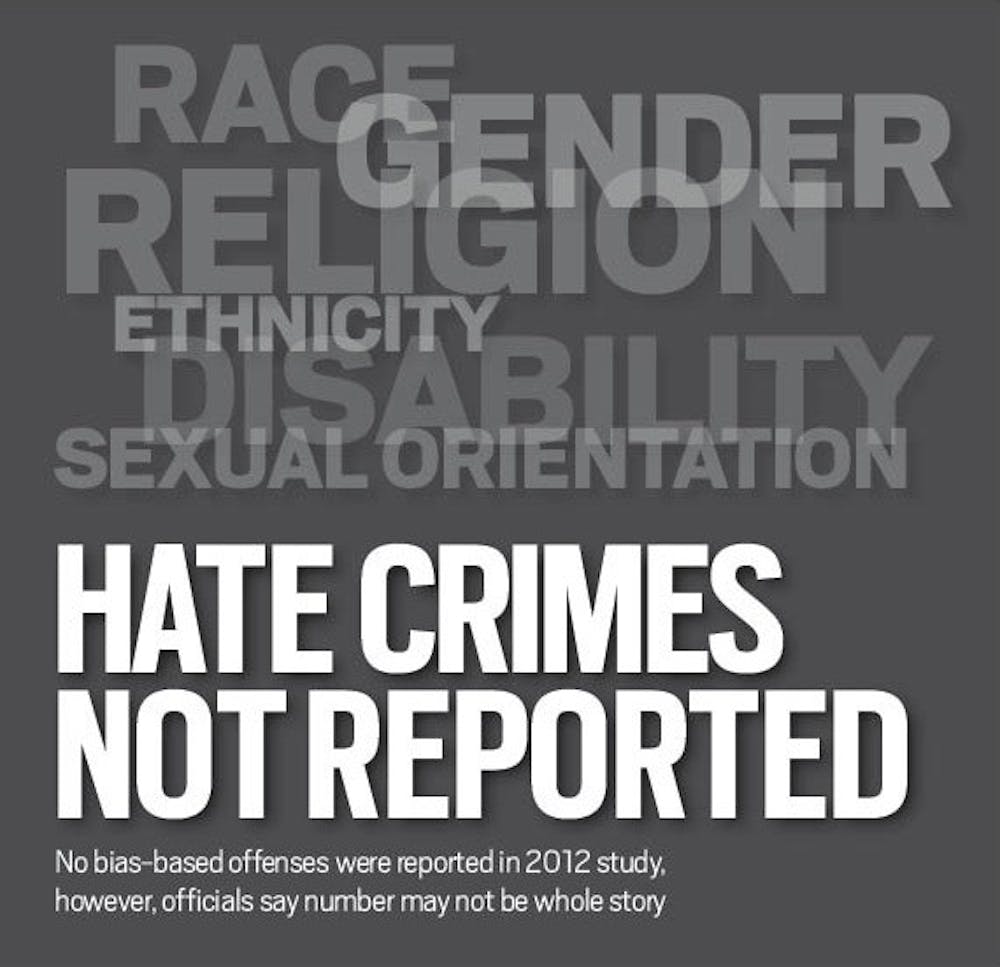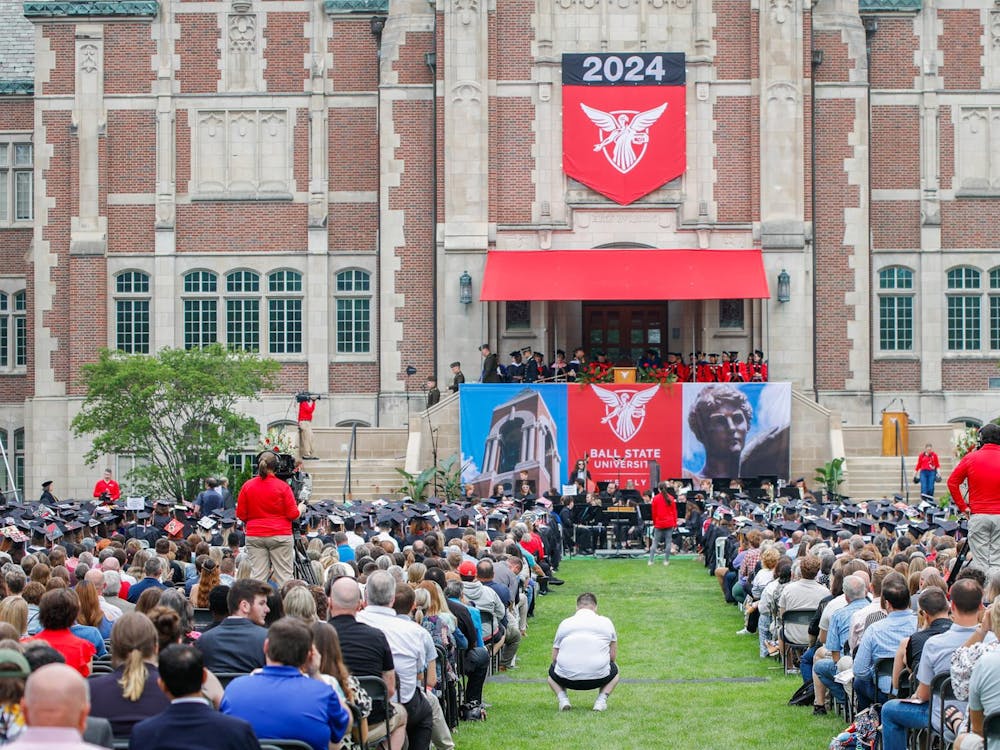*The Clery Act’s definition of Hate Crime *
A criminal act involving one/more of… the crimes of theft, simple assault, intimidation or vandalism, or any other crime involving bodily injury which was motivated by bias against any person or group of persons, or the property of any person or group of persons because of their actual or supposed:
• ethnicity
• race
• national origin
• religion
• gender
• sexual orientation
• disability
Source: northwestern.edu
University officials said it is unclear whether or not the reported zero hate crimes on campus is an accurate representation of Ball State’s diversity climate.
The 2012 Campus Security Report showed that no hate crimes took place in 2010, 2011 or 2012, but it is only required to report hate crimes that occur on university-controlled property.
“The ‘no hate crimes’ on this report simply indicates we have no reports of crimes that meet the definition, that show evidence of bias in the categories of race, gender, ethnicity, religion, disability or sexual orientation,” Michael Gillilan, director of student rights and community standards, said in an email.
Beyond hate crimes, students may experience bias, which is when someone is targeted because of a prejudice against them, but it is not considered a crime. These incidents do not appear on the report.
“I think we may not have had hate crimes on campus, and that is very encouraging that we did not get to that level where it is classified as a hate crime,” said Ro-Anne Royer, director of the Multicultural Center. “But I don’t know [if that is] contrary to the real campus climate.”
Beth Messner, a communications associate professor, said she thinks bias incidents occur more frequently than actual hate crimes. She conducted an immersive learning project through the Virginia B. Ball Center for Creative Inquiry on hate speech in Indiana and created a website with discussion material for students.
“I would imagine an act of hate [bias incident] is more prevalent because acts are committed without thought,” Messner said. “Something pops out of someone’s mouth, and they don’t realize they are engaging in hate speech. Hate crimes require intent and are more serious.”
Bryan Byers, a criminal justice professor, said hate crimes are particularly devastating to victims.
“Hate crimes are a very different experience because they are being victimized because of who they are that they can’t help,” said Byers, who has published material on hate crimes. “These are crimes that strike to the core of who a person is and their social identity.”
OTHER UNIVERSITIES
IU-Bloomington reported three hate crimes in 2012. All three were acts of vandalism and were motivated by race or ethnicity.
Purdue reported in its Annual Security and Fire Safety Report 2013 that 11 hate crimes in 2012, including simple assault and vandalism, motivated by race, sexual orientation and religion.
The FBI reported there were 6,222 incidents in 2011 in their yearly Hate Crime Statistics. Data from 2012 will be released in December 2013.
Schools and colleges are the third most common location for hate crimes, according to that report, 9.3 percent of hate crimes occurred at schools or colleges.
Only 1.6 percent of total hate crimes in the United States were reported in Indiana.
LACK OF REPORTING
Byers said data on hate crimes, like any crime, depends on citizens’ willingness to report.
“With any reported crime, there is a sizable hidden figure,” he said. “There are hate crimes on college campuses, but we really don’t know how many may be here because of the lack of reporting.”
Ball State’s Title IX deputy coordinator Katie Slabaugh said in the last decade since she has received these reports, sometimes a semester will go by without a single report coming through.
Often, the perpetrator is anonymous to the victim, which deters victims from reporting, Byers said.
“If someone is driving by a group of people walking, and they yell out a nasty epithet, you can report it, but you won’t have the information needed for anyone to be held responsible,” Byers said. “Victims tend to look at those and think it won’t lead anywhere.”
Gene Burton, University Police Department police chief, outlined fear of retaliation as another deterrent to reporting, but he does not think underreporting is an issue at Ball State.
“I know there is a fear that sometimes a victim of a hate crime will not report it for fear of retaliation,” he said in an email. “I do not have a sense that hate crimes are underreported at Ball State.”
BIAS RESPONSE TEAM
About 10 years ago, a group of students were walking down McKinley Avenue when passengers in a car shouted racial insults at them and sprayed the students with water from a large water gun.
That incident, Slabaugh said, prompted the students to approach the Office of Student Affairs and question where they could report this incident because it was not technically a “crime.”
Because of those students, Slabaugh and others established the Bias Response Team to bring together already existing university services to aid students affected by hate or bias.
Students can report a hate crime or bias incidents using the bias incident report form on bsu.edu. The report asks to describe the nature of the incident, where it occurred, what the motivation may have been and gives responders the option to remain anonymous.
Slabaugh said when she receives a report, she helps students decide if they want to file a police report or a report with the Office of Student Rights and Community Standards, and can direct them to counseling or help them if they have been absent from classes.
“I want students to know the institution does care and does want to respond,” she said. “Their say-so isn’t taken away from them. The university isn’t going to commandeer their life like an emergency response team.”
If the activity is classified as a hate crime and the student wants to report, UPD will handle it.
According to the Student Code, consequences for harassment based on bias can range from an official reprimand to expulsion depending on the severity of the incident and prior conduct.
Slabaugh encouraged students to report because this is the only time in their lives when so many resources will be available for help.
“Once you graduate and enter the world, you may have a human resources department to talk to,” she said. “But the university is a distinct time when you are a member of a community [that is] inclusive and supportive of one another.”





